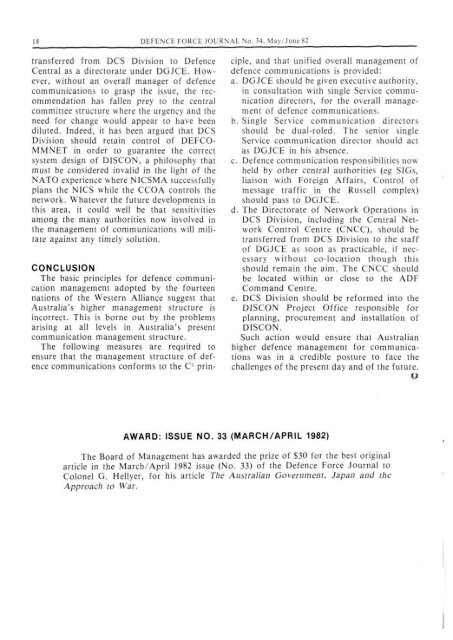ISSUE 34 : May/Jun - 1982 - Australian Defence Force Journal
ISSUE 34 : May/Jun - 1982 - Australian Defence Force Journal
ISSUE 34 : May/Jun - 1982 - Australian Defence Force Journal
Create successful ePaper yourself
Turn your PDF publications into a flip-book with our unique Google optimized e-Paper software.
DEFENCE FORCE JOURNAL No. <strong>34</strong>, <strong>May</strong>/<strong>Jun</strong>e 82<br />
transferred from DCS Division to <strong>Defence</strong><br />
Central as a directorate under DGJCE. However,<br />
without an overall manager of defence<br />
communications to grasp the issue, the recommendation<br />
has fallen prey to the central<br />
committee structure where the urgency and the<br />
need for change would appear to have been<br />
diluted. Indeed, it has been argued that DCS<br />
Division should retain control of DEFCO-<br />
MMNET in order to guarantee the correct<br />
system design of D1SCON, a philosophy that<br />
must be considered invalid in the light of the<br />
NATO experience where NICSMA successfully<br />
plans the NICS while the CCOA controls the<br />
network. Whatever the future developments in<br />
this area, it could well be that sensitivities<br />
among the many authorities now involved in<br />
the management of communications will militate<br />
against any timely solution.<br />
CONCLUSION<br />
The basic principles for defence communication<br />
management adopted by the fourteen<br />
nations of the Western Alliance suggest that<br />
Australia's higher management structure is<br />
incorrect. This is borne out by the problems<br />
arising at all levels in Australia's present<br />
communication management structure.<br />
The following measures are required to<br />
ensure that the management structure of defence<br />
communications conforms to the O principle,<br />
and that unified overall management of<br />
defence communications is provided:<br />
a. DGJCE should be given executive authority,<br />
in consultation with single Service communication<br />
directors, for the overall management<br />
of defence communications.<br />
b. Single Service communication directors<br />
should be dual-roled. The senior single<br />
Service communication director should act<br />
as DGJCE in his absence.<br />
c. <strong>Defence</strong> communication responsibilities now<br />
held by other central authorities (eg SIGs,<br />
liaison with Foreign Affairs, Control of<br />
message traffic in the Russell complex)<br />
should pass to DGJCE.<br />
d. The Directorate of Network Operations in<br />
DCS Division, including the Central Network<br />
Control Centre (CNCC), should be<br />
transferred from DCS Division to the staff<br />
of DGJCE as soon as practicable, if necessary<br />
without co-location though this<br />
should remain the aim. The CNCC should<br />
be located within or close to the ADF<br />
Command Centre.<br />
e. DCS Division should be reformed into the<br />
DISCON Project Office responsible for<br />
planning, procurement and installation of<br />
DISCON.<br />
Such action would ensure that <strong>Australian</strong><br />
higher defence management for communications<br />
was in a credible posture to face the<br />
challenges of the present day and of the future.<br />
AWARD: <strong>ISSUE</strong> NO. 33 (MARCH/APRIL <strong>1982</strong>)<br />
The Board of Management has awarded the prize of $30 for the best original<br />
article in the March/April <strong>1982</strong> issue (No. 33) of the <strong>Defence</strong> <strong>Force</strong> <strong>Journal</strong> to<br />
Colonel G. Hellyer, for his article The <strong>Australian</strong> Government, Japan and the<br />
Approach to War.

















